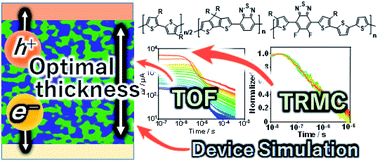Quantifying the optimal thickness in polymer:fullerene solar cells from the analysis of charge transport dynamics and photoabsorption†
Abstract
The optimal photoactive layer thickness (Lopt) of bulk heterojunction (BHJ) organic solar cells (OSCs) is typically below 200 nm, which is unlikely suitable for large scale production. Toward increasing the Lopt, a deeper understanding of Lopt is indispensable. Here, we propose a semi-empirical model for the quantitative determination of Lopt in OSCs, which considers the limited charge carrier transport length, space charge accumulation, and photoabsorption. Three widely studied BHJs of polymer:fullerene OSCs (P3HT, PffBT4T, and PCPDTBT each blended with PCBM) were used for the validation of this model. Simultaneous measurements of time-of-flight (TOF) and time-resolved microwave conductivity (TRMC) revealed the electron/hole mobility relaxation and effective carrier diffusion length. The space charge effect on Lopt was examined by considering the electron/hole mobility balance. In addition, the photoabsorption effect was incorporated by calculating the effective absorption coefficient under the standard solar irradiation. Based on this model, Lopt was calculated to be ∼100 nm for PCPDTBT/PC71BM, ∼150 nm for P3HT/PCBM, and ∼300 nm for PffBT4T/PCBM, showing good consistence with the experimental values. The effectiveness of our model was further supported by solar cell capacitance simulator (SCAPS) calculations. Thus, our work provides a feasible method for quantifying Lopt in OSCs and an insight into the charge relaxation dynamics.



 Please wait while we load your content...
Please wait while we load your content...